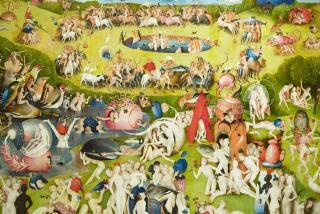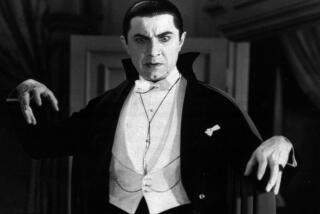In ‘The Weird,’ Ann and Jeff VanderMeer air the eerie
- Share via
And now for something completely weird.
Not weird as in the crackpot relative who likes to live off the grid and eat worms for breakfast, but weird as in spine-tingling, uncanny and vaguely disturbing.
We’ve all had encounters of the weird kind. They’re inexplicably unsettling. Without our being able to put a finger on it, they make us feel uncomfortable. “Weird” is often the reason why campfire stories exist and are so effective — they play on our suspicions that not all is as it seems, that there are darker realities to explain things that science has missed altogether.
As it turns out, these types of stories have a genre all to themselves.
Ann VanderMeer and her husband, novelist Jeff VanderMeer, have recently (and lovingly) curated a collection of such stories in their doorstop of a book, “The Weird: A Compendium of Strange and Dark Stories” (Tor Books: 1,126 pp., $29.99 paper).
Some of the book’s 110 stories were written by masters of the weird, including Neil Gaiman, Franz Kafka, H.P. Lovecraft and the recently departed Ray Bradbury. But there are other authors the Vandermeers have included — Haruki Muramaki, Joyce Carol Oates and Jorge Luis Borges, among them — who may not have set out on a purposeful march toward a very weird place when they wrote their stories but wind up there nonetheless.
The Vandermeers, who live in Tallahassee, Fla., spoke to The Times to explain how they selected the stories and why they don’t believe vampires qualify as card-carrying members of the Truly Weird Club.
How did you go about selecting the stories? What criteria did you use?
Jeff VanderMeer: When you have a chance to do a large, iconic anthology, you don’t want to have a thesis beforehand. We read hundreds of stories, more than 6 million words in total, with an open mind. We tested obscure writers. We tested minor writers. And we found some commonalities. They generally fell into two strands: The first is Lovecraftian. You have an ordinary situation to start, with an ordinary person who encounters something odd or supernatural. The second strain is where everything is surreal and strange, and you’re in the weird nightmare. Those two strands seem to overlap at times.
Define weird.
Ann VanderMeer: Weird is being confronted with something you don’t understand. It makes you feel you’ve lost control. It’s unsettling, uneasy. The driving force is coming across something unknown and that desire to understand.
J.V.: You see this grappling with the world. There are things that religion and science cannot explain. There is still something beyond that. Nothing is in your face the way horror is. It’s not to say there are not stories that have traditional plot structure. They do, but they also have a surreal decadence to them.
Why is horror not weird?
J.V.: Straight-up horror turns back to the ordinary at the end. There are eruptions of horror, and then it returns back to normal. Naturalistic horror is not weird.
A.V.: Typical ghost stories are not weird, because we all know what that is. Somebody died, and they’re haunting you in order to find closure. Then they find it. The end. You know what will happen. The tradition of the last century rules out vampires, werewolves and zombies. There’s nothing new about them. There’s not a sense of the unknown anymore.
Can the march of science in finding answers to every phenomenon obliterate the weird movement?
J.V.: There’s a timeless nature to many of these stories. Because they often refer to temporal landmarks, they don’t become outdated. For this genre, the science doesn’t matter that much. The weird matters.
A.V.: You have to touch on those universal things all people feel. If you remove pop culture references of the day, that helps. All people feel love, fear, desire. If you make characters people relate to, that will make it timeless. Daphne du Maurier’s “Don’t Look Now,” for example, is a story about loss. A husband and wife lost a child. They decide to go on a long trip to deal with their grief. They encounter the weird. But the story is about how they deal with their grief.
When did this genre crop up?
J.V.: This is probably the most controversial question. Arthur Machen [1863-1947] is thought of as the father of modern weird, but he was more of a precursor. Lovecraft claimed that Algernon Blackwood [1869-1951] was the precursor. And Alfred Kubin [1877-1959] represented this lost, Kafkaesque strand of weird.
Some of these stories struck me as intentionally humorous. Kubin’s “The Other Side” described an absurd world that reminded me a lot of the children’s book “Cloudy With a Chance of Meatballs.” Can weird also be funny?
J.V.: There is a strand of sly, dark humor in a lot of these stories. Kubin has a great sense of the absurd. Another humorous one is “The Tarn,” in which Hugh Walpole wrote about the envy between two writers. It’s hilarious and disturbing at the same time.
A.V.: Robert Aickman’s “The Hospice” is quite funny. A man is in a hospice to convalesce and slowly he realizes that the patients in the dining room are chained under the table. It’s actually very disturbing but funny.
J.V.: Lovecraft didn’t know much about birds, but he deployed these giant zombie penguins. As a bird-watcher, I found it hilarious.
More to Read
The biggest entertainment stories
Get our big stories about Hollywood, film, television, music, arts, culture and more right in your inbox as soon as they publish.
You may occasionally receive promotional content from the Los Angeles Times.










